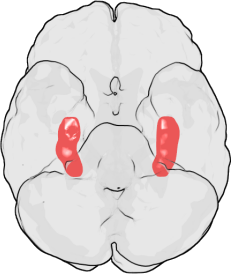
Performance on tests varying in difficulty is also shown ( green bars). Proportion of correct choices as a function of blocks of five training trials (training) and performance in nonrewarded transfer test ( red bar). For impossible trials the center of both targets were in line with that of the reference bar. For difficult trials, targets partially overlapped with the reference bar. For easy trials, the target was clearly above or below the reference bar and did not overlap with the reference bar. In the difficulty tests, the easiness of the discrimination was varied by changing the distance between the target and the horizontal of the reference bar. The transfer tests were unrewarded and used novel targets not used during the training. In the example shown the above relationship was rewarded and the below relationship punished. Between trials, targets and positions of targets, and reference bars were varied so that bees could only learn the above/below relation of targets to the references as predictors of reward. Within a trial, stimulus pairs were identical except for vertical position relative to the reference bar and relative to the bottom of the chamber. Reward (2 M sucrose) or punishment (quinine) was placed in a translucent microcentrifuge tube in the center of the targets. Targets were the same on both sides but variable between the 30 training trials. During the training a horizontal black bar was used as the reference to define the above/below relationship. Metacognitive-like processes in honeybees. While metacognitive research has shown that nonhuman vertebrates (mostly primates) selectively avoid taking difficult tests of memory or perception, collect more information if needed before taking tests, or “gamble” more food reward on correct than on incorrect responses in tests of memory and perception ( Hampton, 2009 Terrace and Son, 2009), a single study has addressed so far the question of whether an insect, the honeybee, may display metacognitive-like processes ( Perry and Barron, 2013).įigure 6. The questions addressed by this research are can an animal report on its own degree of confidence in its behavior, for example by choosing the level of risk or nonrisk in its responses? Can it show that it “does not know” through active research for more information? Cognitive behavioral biology has focused on metacognition as a fundamental way to determine whether animals perform introspective evaluation of their knowledge before engaging or not in a difficult task and thus if a certain level of consciousness is available to them ( Terrace and Son, 2009). If cognition can be considered as the ensemble of faculties that refer to internal representations or context-dependent memories that reflect these contents, metacognition may be considered as the knowledge of these contents (i.e., the knowing to know) ( Terrace and Son, 2009). Martin Giurfa, in Learning and Memory: A Comprehensive Reference (Second Edition), 2017 1.22.7 Metacognitive-Like Processes in Honeybees However, stress and anxiety states may distort the attentional processes rather than the memory processes and hence may lead to distorted encoding of a stimulus due to heightened attention to salient aspects of a traumatic scene. Patients with clinical depression have been found to recall more negatively focused information than nondepressed controls. Mood and retrievalĪ person in a gloomy mood is more likely to recall gloomy information, a person in a happy mood is more likely to remember cheerful information.

Some research suggests that high levels of arousal may lead to enhanced recall under certain circumstances, due to the positive effect of arousal on memory trace consolidation. Motivated forgetting is, however, hard to assess empirically. Clinically, this may be seen in amnesia in patients following severe emotional trauma. Freud argued that painful or emotionally salient memories can be repressed and placed out of conscious access as a protective mechanism. These are also likely to affect recall and forgetting. Retrieval of information is generally better given similar rather than different contextual cues. The place in which the memory was initially encoded for the retrieval of information.


Context and state-dependent memory are concerned with:


 0 kommentar(er)
0 kommentar(er)
